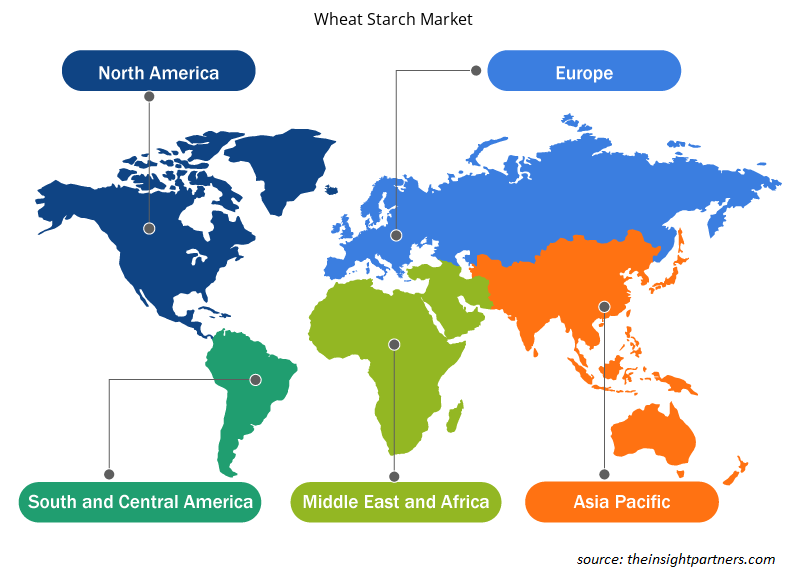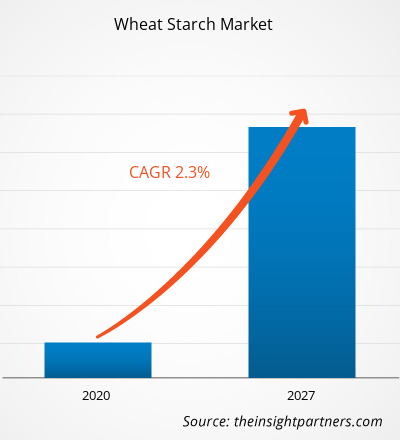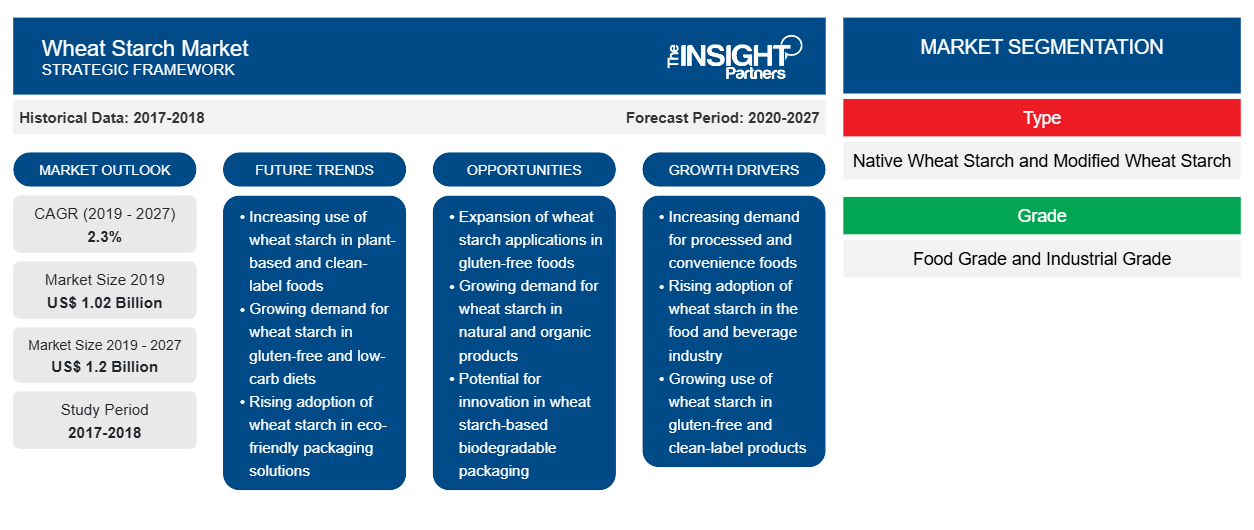بلغت قيمة سوق نشا القمح 1,016.95 مليون دولار أمريكي في عام 2019 ومن المتوقع أن تصل إلى 1,203.32 مليون دولار أمريكي بحلول عام 2027؛ ومن المتوقع أن تنمو بمعدل نمو سنوي مركب قدره 2.3٪ خلال الفترة المتوقعة.
يتميز نشا القمح بخواص التبلور والتثبيت والتكثيف الفائقة. وعند استخدامه في الأطعمة، يساعد نشا القمح في إضفاء الملمس واللزوجة المرغوبين، إلى جانب تمكين تكوين الهلام والترابط والاحتفاظ بالرطوبة. ويُستخدم بشكل أساسي كعامل تكثيف في صناعة الأغذية. ويعمل نشا القمح على تكثيف الطعام من خلال التراجع والتحول إلى هلام. وتتسبب الحرارة في امتصاص النشا للماء وانتفاخه مع زيادة الوضوح واللزوجة. ومع ذلك، بمجرد وصوله إلى مستوى اللزوجة الأقصى، تتباعد الجزيئات، مما يؤدي إلى انخفاض اللزوجة. وعلاوة على ذلك، عندما يبدأ المنتج في التبريد مرة أخرى، تزداد اللزوجة، مما يجعل المحلول غائمًا مما يؤدي إلى تكوين الهلام. وهذا أحد الأسباب التي تجعل مصنعي الأطعمة والمشروبات يفضلون استخدام نشا القمح في المنتجات الغذائية. كما يتزايد استخدام نشا الحرارة في الخبز هذه الأيام. ويمنح نشا القمح المعدل خصائص استحلاب فائقة في بعض المنتجات الغذائية. كما يستخدم في الحلويات مثل الحلوى التركية. كما أنه فعال في تحسين الاحتفاظ بالرأس في البيرة. كما يستخدم في صنع النقانق ولفائف اللحوم. يعد نشا القمح مكونًا رئيسيًا للمعكرونة ويمثل حوالي 70٪ من وزنها. بالمقارنة مع أنواع النشا الأخرى، يزيد نشا القمح من حجم وطراوة الكعك ويساعد أيضًا في امتصاص الدهون في الكعك. يستخدم نشا القمح بشكل شائع في المحليات مثل شراب الجلوكوز والمالتوديكسترين والدكستروز. يتم استخدامه كمثبت في الصلصات والحلويات.
من المتوقع أن تستحوذ منطقة آسيا والمحيط الهادئ على حصة كبيرة من سوق نشا القمح العالمي خلال الفترة المتوقعة. تتمتع العديد من الشركات المحلية والدولية بموطئ قدم قوي في هذه المنطقة. يوفر ارتفاع عدد سكان الطبقة المتوسطة والنمو في التحضر في بلدان منطقة آسيا والمحيط الهادئ العديد من الفرص للاعبين الرئيسيين في سوق نشا القمح. يعد التوافر السهل للمواد الخام (القمح) مفيدًا في تعزيز نمو السوق في منطقة آسيا والمحيط الهادئ. هيمنت الصين على سوق نشا القمح في منطقة آسيا والمحيط الهادئ في عام 2019 ومن المتوقع أن تقود السوق خلال الفترة المتوقعة. تعزى هيمنة الصين بشكل أساسي إلى الإنفاق المتزايد من قبل الشركات على تطوير منتجات نشا القمح المبتكرة ووجود قطاع أغذية ومشروبات راسخ في البلاد
تم الإبلاغ عن تفشي فيروس كورونا المستجد لأول مرة في مدينة ووهان (الصين) في ديسمبر 2019، ومنذ ذلك الحين انتشر بسرعة في جميع أنحاء العالم. اعتبارًا من ديسمبر 2020، كانت الولايات المتحدة والهند والبرازيل وروسيا وفرنسا والمملكة المتحدة وتركيا وإيطاليا وإسبانيا وألمانيا والأرجنتين وكولومبيا والمكسيك من بين الدول الأكثر تضررًا من هذا الوباء. وفقًا لمنظمة الصحة العالمية، اعتبارًا من ديسمبر، كان هناك حوالي 80،773،033 حالة مؤكدة من فيروس كورونا المستجد و1،783،619 حالة وفاة في جميع أنحاء العالم. لقد أثر فيروس كورونا المستجد على الاقتصادات والصناعات في مختلف البلدان بسبب عمليات الإغلاق وحظر السفر وإغلاق الشركات. تعد الأغذية والمشروبات واحدة من الصناعات الرئيسية في العالم التي تعاني من اضطرابات خطيرة مثل انقطاع سلسلة التوريد وإلغاء الأحداث التكنولوجية وإغلاق المكاتب. تعد الصين مركز التصنيع العالمي وأكبر مورد للمواد الخام لمختلف الصناعات. يؤثر إغلاق العديد من المصانع في الصين على سلاسل التوريد العالمية ويؤثر سلبًا على التصنيع وجداول التسليم ومبيعات المواد. وقد أعلنت العديد من الشركات بالفعل عن احتمال حدوث تأخيرات في تسليم المنتجات وانخفاض في مبيعات منتجاتها في المستقبل. وبالإضافة إلى ذلك، فإن حظر السفر العالمي الذي فرضته دول في أوروبا وآسيا وأمريكا الشمالية يؤثر على فرص التعاون والشراكات التجارية.
قم بتخصيص هذا التقرير ليناسب متطلباتك
ستحصل على تخصيص لأي تقرير - مجانًا - بما في ذلك أجزاء من هذا التقرير، أو تحليل على مستوى الدولة، وحزمة بيانات Excel، بالإضافة إلى الاستفادة من العروض والخصومات الرائعة للشركات الناشئة والجامعات
- احصل على أهم اتجاهات السوق الرئيسية لهذا التقرير.ستتضمن هذه العينة المجانية تحليلاً للبيانات، بدءًا من اتجاهات السوق وحتى التقديرات والتوقعات.
رؤى السوق
التطبيقات المحتملة لنشا القمح في التركيبات الصيدلانية تدفع نمو السوق
يبذل الباحثون والصيادلة في جميع أنحاء العالم جهودًا لاكتشاف إمكانات النشا المعدل في التركيبات الصيدلانية للاستفادة من الوظائف المحسنة وقابلية تطبيق هذا النشا. تركز الدراسات على المتطلبات الأساسية للمواد المساعدة الصيدلانية وطرق تعديل النشا مثل الطرق الكيميائية والتكنولوجية الحيوية والفيزيائية. النشا المشتق من القمح والذرة والأرز وغيرها عديم اللون والرائحة وغير قابل للذوبان في الكحول والماء. في إنتاج المستحضرات الصيدلانية، يعمل النشا كعامل مساعد مهم ومتعدد الاستخدامات ورخيص. يتم استكشاف نشا القمح الأصلي جيدًا كمادة رابطة ومفككة في أشكال الجرعات الصلبة. يتم تعديل النشا لتعزيز خصائصه الفيزيائية والكيميائية مثل الملمس والاستقرار واللزوجة للحصول على قدرة تدفق جيدة وقابلية للضغط في التطبيقات الصيدلانية. وبالتالي، يتم تفضيل النشا المعدل الآن كمواد مساعدة قابلة للضغط مباشرة في صناعة المستحضرات الصيدلانية، مما يدفع نمو سوق نشا القمح.
رؤى النوع
على أساس النوع، يتم تقسيم سوق نشا القمح إلى نشا قمح أصلي ونشا قمح معدل. في عام 2019، هيمنت شريحة نشا القمح الأصلي على السوق. يفصل الاستخلاص المادي لنشا القمح الجلوتين عن البروتينات الأخرى. نشا القمح الأصلي هو أيضًا مكون نباتي يستخدم في الأطعمة المشتقة من القمح. إنه مسحوق أبيض إلى أبيض مائل للصفرة ذو رائحة وطعم محايدين. له قيمة طاقة تبلغ 4 كيلو كالوري / جرام، أي مشابه لجميع الكربوهيدرات الأخرى. يستخدم نشا القمح الأصلي كعامل تكثيف وتثبيت وتغميق وتزجيج؛ علاوة على ذلك، يمكن استخدامه أيضًا للربط والاحتفاظ بالرطوبة. يتم استخدامه في الحلويات السكرية ومنتجات المخابز والوجبات الخفيفة ومنتجات الألبان (مثل الجبن) والمشروبات الكحولية والصلصات والحساء والمعكرونة والوجبات الجاهزة واللحوم والمأكولات البحرية (مثل السوريمي).
نظرة عامة على الدرجات
على أساس الدرجة، يتم تقسيم سوق نشا القمح إلى درجة غذائية ودرجة صناعية. في عام 2019، هيمن قطاع درجة الغذاء على السوق. يستخدم نشا القمح بشكل شائع كمكمل غذائي في قطاع الأغذية والمشروبات؛ ويمكن استخدامه أيضًا كبديل للدهون. يعمل كعامل تكثيف في الطعام من خلال عمليات الجلتنة والتراجع. يستخدم نشا القمح الصالح للأكل لتكثيف أو تقوية المنتجات مثل البودنج والحساء والصلصات وحشوات الفطائر. يساعد في الملمس واللزوجة وتكوين الهلام والالتصاق والترابط والاحتفاظ بالرطوبة. هذا النشا هو أيضًا مادة أساسية في المطاعم والفنادق عالية الجودة وتطبيقات الطهي المنزلية.
رؤى حول الاستخدام النهائي للصناعة
بناءً على صناعة الاستخدام النهائي، يتم تقسيم سوق نشا القمح إلى الأغذية والمشروبات ومستحضرات التجميل وغيرها. في عام 2019، هيمن قطاع الأغذية والمشروبات على السوق. في صناعة الأغذية، يستخدم نشا القمح كعامل تكثيف. علاوة على ذلك، نظرًا لقدرته على منع مرونة العجين، فإنه يستخدم على نطاق واسع في قطاع الأغذية والمشروبات كمكثف ومضاف غذائي ومكون نشط. علاوة على ذلك، فهو مفيد في عملية ربط الطعام ويستخدم أيضًا في تحضير الأطعمة الخالية من الغلوتين ومنخفضة السعرات الحرارية. في العديد من تطبيقات الأغذية، يتم استخدامه أيضًا بشكل شائع كمستحلب ومثبت وبديل للدهون وعامل تعكر أو تزجيج. كما يتم استخدامه في وصفات العجين لأغلفة الزلابية الصينية لأنه يساعد في إعطاء اتساق شفاف لأغلفة الزلابية. سيستمر اتجاه استهلاك الأطعمة الخالية من الغلوتين بين المستهلكين في تفضيل استخدام نشا القمح في صناعة الأغذية والمشروبات.
تشمل الجهات الفاعلة الرئيسية المتواجدة في سوق نشا القمح العالمي شركة Cargill Incorporated، وRoquetteFreres، وManildra Group، وMGP Ingredients، وThe Archer-Daniels-Midland Company، وAgrana Group، وTereos SA، وCrespel and Deiters، وNew Zealand Starch Company، وSacchettoS.pA. تعمل هذه الشركات على تنفيذ تطويرات المنتجات الجديدة، واستراتيجيات الدمج والاستحواذ لتوسيع قاعدة عملائها والحصول على حصة سوقية كبيرة في جميع أنحاء العالم، مما يسمح لها بدوره بالحفاظ على اسم علامتها التجارية عالميًا.
نظرة إقليمية على سوق نشا القمح
لقد قام المحللون في Insight Partners بشرح الاتجاهات والعوامل الإقليمية المؤثرة على سوق نشا القمح طوال فترة التوقعات بشكل شامل. يناقش هذا القسم أيضًا قطاعات سوق نشا القمح والجغرافيا في جميع أنحاء أمريكا الشمالية وأوروبا ومنطقة آسيا والمحيط الهادئ والشرق الأوسط وأفريقيا وأمريكا الجنوبية والوسطى.

- احصل على البيانات الإقليمية المحددة لسوق نشا القمح
نطاق تقرير سوق نشا القمح
| سمة التقرير | تفاصيل |
|---|---|
| حجم السوق في عام 2019 | 1.02 مليار دولار أمريكي |
| حجم السوق بحلول عام 2027 | 1.2 مليار دولار أمريكي |
| معدل النمو السنوي المركب العالمي (2019 - 2027) | 2.3% |
| البيانات التاريخية | 2017-2018 |
| فترة التنبؤ | 2020-2027 |
| القطاعات المغطاة | حسب النوع
|
| المناطق والدول المغطاة | أمريكا الشمالية
|
| قادة السوق وملفات تعريف الشركات الرئيسية |
|
كثافة اللاعبين في سوق نشا القمح: فهم تأثيرها على ديناميكيات الأعمال
يشهد سوق نشا القمح نموًا سريعًا، مدفوعًا بالطلب المتزايد من المستخدم النهائي بسبب عوامل مثل تفضيلات المستهلكين المتطورة والتقدم التكنولوجي والوعي المتزايد بفوائد المنتج. ومع ارتفاع الطلب، تعمل الشركات على توسيع عروضها والابتكار لتلبية احتياجات المستهلكين والاستفادة من الاتجاهات الناشئة، مما يؤدي إلى زيادة نمو السوق.
تشير كثافة اللاعبين في السوق إلى توزيع الشركات أو المؤسسات العاملة في سوق أو صناعة معينة. وهي تشير إلى عدد المنافسين (اللاعبين في السوق) الموجودين في مساحة سوق معينة نسبة إلى حجمها أو قيمتها السوقية الإجمالية.
الشركات الرئيسية العاملة في سوق نشا القمح هي:
- شركة كارغيل
- روكيت فرير
- مجموعة مانيلدرا
- مكونات MGP
- شركة آرتشر-دانييلز-ميدلاند
إخلاء المسؤولية : الشركات المذكورة أعلاه ليست مرتبة بأي ترتيب معين.

- احصل على نظرة عامة على أهم اللاعبين الرئيسيين في سوق نشا القمح
تقرير يسلط الضوء على
- اتجاهات الصناعة التقدمية في سوق نشا القمح العالمية التي تساعد اللاعبين على تطوير استراتيجيات فعالة طويلة الأجل
- استراتيجيات نمو الأعمال التي تتبناها الشركات في الأسواق المتقدمة والنامية
- التحليل الكمي لسوق نشا القمح من 2017 إلى 2027
- تقدير الطلب على نشا القمح عبر مختلف الصناعات
- تحليل PEST لتوضيح فعالية المشترين والموردين العاملين في الصناعة
- التطورات الأخيرة لفهم سيناريو السوق التنافسية والطلب على نشا القمح
- اتجاهات السوق وتوقعاته والعوامل التي تدفع وتكبح نمو السوق
- فهم الاستراتيجيات التي تدعم المصلحة التجارية فيما يتعلق بنمو السوق
- حجم سوق نشا القمح في مختلف مناطق السوق
- نظرة عامة مفصلة وتقسيم السوق، بالإضافة إلى ديناميكيات صناعته
- حجم سوق نشا القمح العالمي في مناطق مختلفة مع فرص نمو واعدة في المناطق المعنية
سوق نشا القمح حسب النوع
- نشا القمح الأصلي
- نشا القمح المعدل
سوق نشا القمح حسب الدرجة
- درجة الغذاء
- درجة صناعية
سوق نشا القمح حسب الصناعة المستخدمة
- الأطعمة والمشروبات
- مستحضرات التجميل
- آحرون
نبذة عن الشركة
- شركة كارغيل
- روكيت فريريس
- مجموعة مانيلدرا
- مكونات MGP
- شركة آرتشر-دانييلز-ميدلاند
- مجموعة أجرانا
- تيريوس SA
- كريسبيل وديترز
- شركة النشا النيوزيلندية
- ساكييتو سبا
- التحليل التاريخي (سنتان)، سنة الأساس، التوقعات (7 سنوات) مع معدل النمو السنوي المركب
- تحليل PEST و SWOT
- حجم السوق والقيمة / الحجم - عالمي، إقليمي، بلد
- الصناعة والمنافسة
- مجموعة بيانات إكسل
التقارير الحديثة
شهادات العملاء
سبب الشراء
- اتخاذ قرارات مدروسة
- فهم ديناميكيات السوق
- تحليل المنافسة
- رؤى العملاء
- توقعات السوق
- تخفيف المخاطر
- التخطيط الاستراتيجي
- مبررات الاستثمار
- تحديد الأسواق الناشئة
- تحسين استراتيجيات التسويق
- تعزيز الكفاءة التشغيلية
- مواكبة التوجهات التنظيمية





















 احصل على عينة مجانية ل - سوق نشا القمح
احصل على عينة مجانية ل - سوق نشا القمح